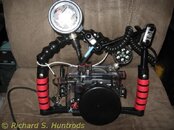bubble doctor
Registered
Hi!
First post to scuba board . I am looking into my first camera (largely encouraged by an upcoming liveaboard trip that I at least want happy snaps from!) I have done some work with DSLR's on shore and am interested in getting something I can grow with (controlling settings manually). At the moment I'm thinking Canon G16 with Fantasea casing. I am on a budget and didn't want to start with a big rig. Was hoping to start without a strobe (using internal flash) and without a wide angle lens and then add on bits as I want to improve my photos and as my skills get better. To start with I'm aiming for generally in focus and identifiable creatures
. I am looking into my first camera (largely encouraged by an upcoming liveaboard trip that I at least want happy snaps from!) I have done some work with DSLR's on shore and am interested in getting something I can grow with (controlling settings manually). At the moment I'm thinking Canon G16 with Fantasea casing. I am on a budget and didn't want to start with a big rig. Was hoping to start without a strobe (using internal flash) and without a wide angle lens and then add on bits as I want to improve my photos and as my skills get better. To start with I'm aiming for generally in focus and identifiable creatures  . I'm not really sure about the focus light part either? I've read the G16 is said to be good at macro and a little more limited for wide angle without a lens. Is it super-limiting or just 'not as good as others' as far as photos like turtles/big fish/other dive buddies go?
. I'm not really sure about the focus light part either? I've read the G16 is said to be good at macro and a little more limited for wide angle without a lens. Is it super-limiting or just 'not as good as others' as far as photos like turtles/big fish/other dive buddies go?
Thanks heaps!
First post to scuba board
Thanks heaps!





